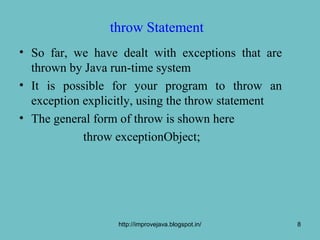Multi catch statement
- 1. The concept of multi-catch http://improvejava.blogspot.in/ 1
- 2. Objectives On completion of this period, you would be able to know : • The concept of multi-catch statements • The usage of finally block • Related programs http://improvejava.blogspot.in/ 2
- 3. Recap In the last class, you have studied about the usage of Java keywords • We have also written simple program using try and catch http://improvejava.blogspot.in/ 3
- 4. Multiple catch Statements 1. Some times more than one exception can be raised 2. You can specify two or more catch blocks, each catching a different type of exception 3. When an exception is thrown, each catch block is inspected in order http://improvejava.blogspot.in/ 4
- 5. Multiple catch Statements Contd.. 1. First exception handler whose type matches that of the generated exception is executed 2. If any one catch statement executes, the others are bypassed, and execution continues after the try/catch block http://improvejava.blogspot.in/ 5
- 6. Java Program Using Multi-catch // program for multiple catch statements class MultiCatch { public static void main(String args[]) { try { int a = args.length; System.out.println("a = " + a); int b = 42 / a; int c[] = { 1 }; c[42] = 99; } catch(ArithmeticException e) { System.out.println("Divide by 0: " + e); } catch(ArrayIndexOutOfBoundsException e) { System.out.println("Array index Out of bounds: " + e); } System.out.println("After try/catch blocks."); } } http://improvejava.blogspot.in/ 6
- 7. Explanation : • This program catches two exceptions, namely • ArithmeticException • ArrayIndexOutOfBoundsException http://improvejava.blogspot.in/ 7
- 8. throw Statement • So far, we have dealt with exceptions that are thrown by Java run-time system • It is possible for your program to throw an exception explicitly, using the throw statement • The general form of throw is shown here throw exceptionObject; http://improvejava.blogspot.in/ 8
- 9. throws Clause • A throws clause lists the types of exceptions that a method might throw • This is necessary for all exceptions, except those of type Error or RuntimeException, or any of their subclasses • All other exceptions that a method can throw must be declared in the throws clause http://improvejava.blogspot.in/ 9
- 10. throws Clause contd.. • General form of a method declaration that includes a throws type method • ret-type name(parameter-list) throws exception-list { // body of method } • Here, exception-list is a comma-separated list of exception names http://improvejava.blogspot.in/ 10
- 11. finally Block • finally block creates a block of code that will be executed after a try/catch block has completed • And before the code following the try/catch block • The finally block is compulsorily executed whether or not an exception is thrown • If an exception is thrown, the finally block will execute even if no catch statement matches the exception • finally block is useful for doing clean-up work e.g. : To close an opened file To close a database connection etc http://improvejava.blogspot.in/ 11
- 12. An Example For finally Block class finallyDemo { public static void main(String[] args){ int [] a= new int [5]; try{ for(int i=0; i<=5; i++){ a[i] = (i-1)/i; System.out. println(a[i]); } }catch (Exception e){ System. out. println(e); }finally{ System. out. println(“this line is certainly printed”); } } http://improvejava.blogspot.in/ 12 }
- 13. Explanation • The above program ones finally block • It generates ‘ArithmeticException’ as division by zero occurs • The statement in finally block will be compulsorily executed http://improvejava.blogspot.in/ 13
- 14. Discussion • Give one situation for using multi-catch statement • In file processing • What is the purpose of ‘finally’ block • To do clean-up code • How many ‘finally’ block can be there for one try block • One is enough http://improvejava.blogspot.in/ 9CM604.45 14
- 15. Summary • Some times more than one exception can be raised • You can specify two or more catch clauses, each catching a different type of exception • The finally block will execute whether or not an exception is thrown http://improvejava.blogspot.in/ 15
- 16. Quiz 1. We can not raise more than one exception A. True B. False http://improvejava.blogspot.in/ 16
- 17. Quiz 2. A throws clause lists the types of exceptions that a method might throw A. True B. False http://improvejava.blogspot.in/ 17
- 18. Frequently Asked Questions 1. Explain the concept of multi-catch statements 2. Explain how nested try statement can be used 3. Explain the throw and throws clauses 4. Write a sample Java program to demonstrate use of multiple catches http://improvejava.blogspot.in/ 18





![Java Program Using Multi-catch
// program for multiple catch statements
class MultiCatch {
public static void main(String args[]) {
try {
int a = args.length;
System.out.println("a = " + a);
int b = 42 / a;
int c[] = { 1 };
c[42] = 99;
} catch(ArithmeticException e) {
System.out.println("Divide by 0: " + e);
} catch(ArrayIndexOutOfBoundsException e) {
System.out.println("Array index Out of bounds: " + e);
}
System.out.println("After try/catch blocks.");
}
}
http://improvejava.blogspot.in/ 6](https://image.slidesharecdn.com/multicatchstatement-130306072624-phpapp02/85/Multi-catch-statement-6-320.jpg)





![An Example For finally Block
class finallyDemo {
public static void main(String[] args){
int [] a= new int [5];
try{
for(int i=0; i<=5; i++){
a[i] = (i-1)/i;
System.out. println(a[i]);
}
}catch (Exception e){
System. out. println(e);
}finally{
System. out. println(“this line is certainly printed”);
}
}
http://improvejava.blogspot.in/ 12
}](https://image.slidesharecdn.com/multicatchstatement-130306072624-phpapp02/85/Multi-catch-statement-12-320.jpg)





